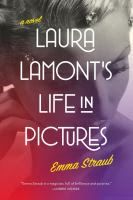One of my favorite things in my home is a photo of a woman, taken sometime during the 1940s or 1950s. She's wearing a bathing suit that could best be described as "glamorous," and she's posing in front of a backdrop filled with giant carrots. There's an inscription in the corner of the photo: Joy Barlow. When I bought the photo for ten cents at a local thrift store, I thought she was a local beauty queen or aspiring model. But research told me something different: she was an actress who appeared, most memorably, in The Big Sleep. Most of her roles were bit parts; a number of them were uncredited.
As I read Laura Lamont's Life in Pictures, I kept thinking of my photo of Joy Barlow. Their stories could be similar. Born Elsa Emerson in Door County, Wisconsin, a locale known for its natural beauty (and its cherry orchards), Laura grows up in her family's theater, a summer-stock company catering to the area's vacationers. Her glamorous older sister, Hildy, falls for a young actor. Their relationship falls apart, and Hildy, prone to depression, commits suicide--an event that will haunt Laura for the rest of her life.
Laura's "life in pictures" is both literal -- she's a film star -- and metaphorical. Straub tells the story in a series of vignettes from different eras of Laura's life. The chapters read like a scrapbook from her life. There's her idyllic youth, shattered by Hildy's suicide. There's her first stage performances at her parents' theatre, where she meets Gordon Pitts, who she marries and follows to California. There's her rise as part of the studio system that was so dominant in mid-20th century Hollywood. There's the pinnacle of her career -- an Oscar! -- and her dramatic fall, including the requisite B-movie (in 3D, no less). At the end, finally, there's her redemption, and a reconciliation of Elsa Emerson, the girl from Wisconsin, and Laura Lamont, the movie star.
Straub does a marvelous job bringing Old Hollywood to life, showing how the movie stars' lives changed as television became a dominant medium in the United States. Laura's attempt to resurrect her career by appearing on a television game show will be familiar to anyone who has ever seen a long-forgotten celebrity embarrass herself on national television, just for a paycheck. Though Laura is brought low, she never loses her dignity, even when she appears on a Japanese commercial for a perfume intended to invoke the spirit of Hollywood's golden age.
Though Laura Lamont may make readers think of other movie stars of the 1940s and 1950s, and the story almost seems rooted in the "small-town girl makes good" myth that has driven many young women to pursue their screen-star dreams, she's her own woman, a unique creation of the author. That's what makes her (and this novel) so special. She's distant and untouchable, a moody, glamorous actress, but she's also a wife, a mother, a daughter, and a sister. Her life is both dramatic and quotidian, and her struggles are realistic. Straub's exploration of celebrity and womanhood is engaging, enjoyable, and highly recommended.


No comments:
Post a Comment